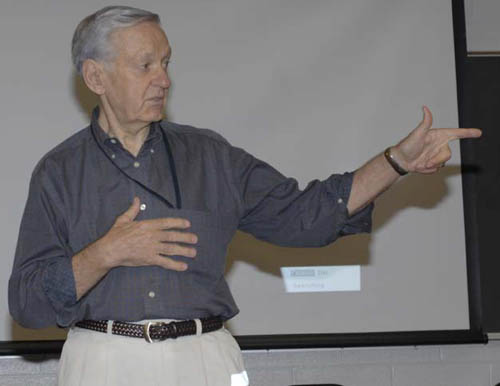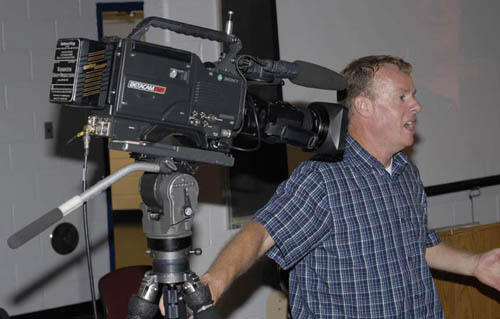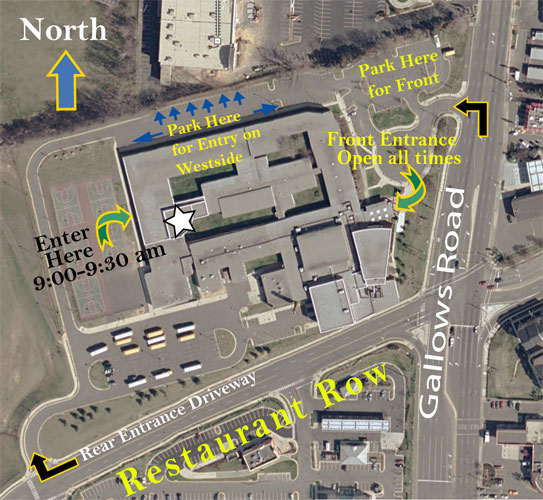



Over sixty members and non-members turned out on a muggy day to hear two outstanding speakers on two quite different aspects of the visual arts. Pat Fauquet answered their Mac questions at the start and conducted the prize drawings at the end. Everyone exhibited solid enjoyment with the program and each other's company.
Facilitating the camaraderie was a twenty-minute coffee break between the featured speakers that gave everyone a chance to stand up and stretch, talk with their neighbors, and enjoy the hot coffee provided. Time passed quickly as there was much to talk about.
Just before the end of the meeting, three lucky members, who had remembered to sign in when they arrived, were declared prizewinners. They were each rewarded a certificate for an hour of tutorial help from Bob LeVitus (aka Dr. Mac) Consulting that would be conducted by Pat. The three winners were Gene Haddon, Gordon Kirschner, and Charles Parsons.
After the meeting, a small group headed over to a nearby Mexican restaurant to continue the pleasures of the day and to enjoy some good food.

Robert Rhodes describes how he made a “remembrance video” to commemorate the 60th anniversary of the Battle of the Bulge, a pivotal event in World War II, during his presentation at the August General Meeting. (Photo by Richard Sanderson)
Our first speaker was Bob Rhodes who specializes in making "remembrance videos." He used as an example the making of video to commemorate the 60th anniversary of the famous Battle of the Bulge fought along the border between Belgium and Germany in December 1944. You can read more about that battle here:
http://en.wikipedia.org/wiki/Battle_of_the_Bulge
Bob was invited to join veterans of the battle and their families on a trip in 2005 to revisit over a dozen towns and cities where the various battles took place over 60 years ago. They were greeted by many Belgians and were honored in various ways during their two-week visit. Bob was there to photographically record their experiences and to later edit them into what turned into a 6-minute video accompanied by recorded music. At the end, Bob showed us his creation, and received warm applause.
Bob bought some new photographic equipment and computer software for the project and said it was quite a learning experience; next time, he plans to better apply these lessons he learned along the way:

After setting up an array of lighting and camera equipment, Grant Peacock gave a spectacular demonstration of how subtle changes in lighting can vastly improve video during the August General Meeting. (Photo by Richard Sanderson)
After the coffee and conversation break, Grant Peacock showed us many of the tricks he uses to light a first-person interview for later broadcast, and get the job done quickly, professionally, and with outstanding results. A handout Grant passed out reads in part:
Grant first showed us how to set up the video camera and chairs for interviewer and interviewee so that the two people are facing each other about 6 feet apart, with the camera looking over one shoulder of the interviewer.
The first lamp used to light the seated interviewee's face is the "Key" light source. Grant used a 1000 watt white lamp with two silk screens in front of the reflector to diffuse, or soften, the light, plus a black collapsible grid in front of the screens to limit the amount of spill light radiating towards the background. The key light is positioned to illuminate the interviewee's cheek that is 'off-camera;' i.e., the cheek away from the lens.
Since the video camera's output was being projected on a large screen behind Grant, we could instantly see the effect of every change in lighting he made. This proved to be very effective in making his verbal prescriptions meaningful to us.
He then added a second "Back" light above and behind the interviewee to light head-and-shoulders in order to make the interviewee stand out visually against the background. He turned the back lamp on and off to show how dramatic this effect can be.
If one has the setup time, additional light sources can be used to advantage. For example, to illuminate the background and to better illuminate the interviewee's face. For the latter, he used a silvered reflector set up close, but off-camera, to re-direct available light to the “on-camera” side of the face.
Grant talked about other problems that can arise and how to deal with them, such as undesirable reflections off eyeglasses not treated to reduce them, and subtle differences in how one might light the face of a female subject versus that of a male subject. He noted that if the camera is looking up at the interviewee, this visually enhances the subject's stature; if the camera is looking down on the subject, it has the opposite effect.
The last thing to do before starting a recording session is to "bless the shot," which means to look carefully at everything the camera is seeing to make sure that nothing is amiss; e.g., the subject's tie is straight and his shirt isn't unbuttoned. Such problems cannot be fixed without being noticed after recording has begun.
Grant can be contacted via the Pi's TCS message boards. Copies of his five-page handout on this subject are available on request.
The August meeting features two sides of video. Joining us will be two Pi members with totally different approaches to making movies. Robert Rhodes is a specialist in making "remembrance" videos. Using thousands of photos, both historical and current, Bob has told the stories of D-Day, the Korean War Memorial and his high school and West Point classes. He combines the images with music to create compelling documentaries. Bob will tell us how to organize such projects and show portions of some of his videos.
Then we will hear from Grant Peacock, a professional who shoots current events, news specials and corporate videos. Although he has lots of lights, microphones, reflectors and gear at his disposal, he is the master of minimalist shooting for professional results. Grant will show us how to frame shots, shoot logical sequences, and enhance lighting and sound for the non-professional.
The meeting will begin with a Q&A session and there will be an unConference coffee break with the latest in current topics.
The meeting will begin at 9:30 and will wrap up between 12 and 12:30. The address is 3020 Gallows Road, Falls Church, VA. Check out the directions and location map at link below.

Questions: Contact the WAP office at (301) 984-0300.
The meeting, open to the public, starts at 9:30 a.m.